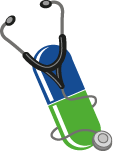Key messages for hospital pharmacists
These key messages were developed as part of a toolkit aimed at promoting prudent use of antibiotics in hospitals and other healthcare settings through dissemination of evidence-based educational and information materials.
Download

Tasks
1. Your tasks related to improving antibiotic use include [42,56,76,94,95]:
a) Participating in the antibiotic stewardship team, as a key member of the team;
b) Collaborating with the infectious disease specialist and the clinical microbiologist to implement the antibiotic stewardship programme;
c) Improving the quality of antibiotic prescribing (e.g. checking for drug interactions, optimising dosage and route of administration, preventing adverse events);
d) Consulting with hospital prescribers and providing them with feedback to ensure the quality of antibiotic prescribing;
e) Implementing interventions on formulary restrictions, such as pre-approval and post-authorisation requirements, and assessing compliance with these restrictions;
f) Analysing data on antibiotic use and costs for the purpose of surveillance and benchmarking;
g) Supporting evidence-based hospital antibiotic guidelines for common infections and for surgical prophylaxis;
h) Managing your hospital’s antimicrobial formulary (i.e., list of drugs available for prescribers).
Things you should know
2. Compliance with formulary restrictions as well as pre-approval and post-authorisation requirements for specific antibiotics decreases the use of these antibiotics in intensive care unit settings [43].
3. Pharmacist-led parenteral-to-oral switches improve clinical outcomes (e.g. shortening the duration of parenteral therapy without negatively impacting on clinical outcomes) [56].
4. Special order forms limit the duration of perioperative antibiotic prophylaxis and reduce the incidence of surgical site infections, antibiotic use and costs [56].
5. Pharmacists can have multiple roles in the emergency department, including giving real-time feedback and consultation regarding prescribing practices, and identifying drug interactions. These reduce treatment durations and lower the overall cost of care [77].
Things you can do, or collaborate on
6. Support the development and implementation of an antibiotic stewardship programme within your organisation [69,94].
7. Provide feedback and advice to prescribers on antibiotic choice, dose, duration optimisation and route of administration [31,94].
8. Encourage clinicians to perform appropriately timed parenteral-to-oral switches [56].
9. Check that antibiotic prescriptions follow antibiotic treatment protocols, based on evidence-based guidelines. If you see staff members at the hospital or healthcare setting who breach guidelines or protocols, ask them why they are doing so and provide them with tools to understand what they are doing wrong [69] [expert consensus].
10. Collect and share data on antibiotic use and costs at ward level and hospital level [56,76].
11. Together with prescribers, provide patients who have to continue antibiotic therapy after discharge with information on use of antibiotics at home [31].
12. Train hospital prescribers regularly on prudent antibiotic use and participate in meetings on implementing evidence-based hospital antibiotic guidelines [31,53,94,95].

